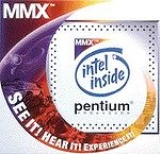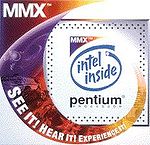
MMX
Encyclopedia

SIMD
Single instruction, multiple data , is a class of parallel computers in Flynn's taxonomy. It describes computers with multiple processing elements that perform the same operation on multiple data simultaneously...
(SIMD) instruction set
Instruction set
An instruction set, or instruction set architecture , is the part of the computer architecture related to programming, including the native data types, instructions, registers, addressing modes, memory architecture, interrupt and exception handling, and external I/O...
designed by Intel, introduced in 1996 with their P5
P5 (microarchitecture)
The original Pentium microprocessor was introduced on March 22, 1993. Its microarchitecture, deemed P5, was Intel's fifth-generation and first superscalar x86 microarchitecture. As a direct extension of the 80486 architecture, it included dual integer pipelines, a faster FPU, wider data bus,...
-based Pentium line of microprocessor
Microprocessor
A microprocessor incorporates the functions of a computer's central processing unit on a single integrated circuit, or at most a few integrated circuits. It is a multipurpose, programmable device that accepts digital data as input, processes it according to instructions stored in its memory, and...
s, designated as "Pentium with MMX Technology". It developed out of a similar unit introduced on the Intel i860
Intel i860
The Intel i860 was a RISC microprocessor from Intel, first released in 1989. The i860 was one of Intel's first attempts at an entirely new, high-end instruction set since the failed Intel i432 from the 1980s...
, and earlier the Intel i750
Intel i750
The i750 was Intel's first attempt to break into the video controller marketplace. The effort was a failure and led to Intel leaving the market for some time. The Indeo video compressor was originally built to work with the i750, but was later ported to other systems as well....
video pixel processor. MMX is a processor supplementary capability
Processor supplementary capability
A processor supplementary capability is a feature that has been added to an existing central processing unit design after the initial introduction of that design to the marketplace....
that is supported on recent IA-32
IA-32
IA-32 , also known as x86-32, i386 or x86, is the CISC instruction-set architecture of Intel's most commercially successful microprocessors, and was first implemented in the Intel 80386 as a 32-bit extension of x86 architecture...
processors by Intel and other vendors.
Naming
MMX is officially a meaningless initialism trademarkTrademark
A trademark, trade mark, or trade-mark is a distinctive sign or indicator used by an individual, business organization, or other legal entity to identify that the products or services to consumers with which the trademark appears originate from a unique source, and to distinguish its products or...
ed by Intel; unofficially, the initials have been variously explained as standing for MultiMedia eXtension, Multiple Math eXtension, or Matrix Math eXtension.
AMD
Advanced Micro Devices
Advanced Micro Devices, Inc. or AMD is an American multinational semiconductor company based in Sunnyvale, California, that develops computer processors and related technologies for commercial and consumer markets...
, during one of its numerous court battles with Intel, produced marketing material from Intel indicating that MMX stood for "Matrix Math Extensions". Since an initialism cannot be trademarked, this was an attempt to invalidate Intel's trademark. In 1997, Intel filed suit against AMD and Cyrix Corp. for misuse of its trademark MMX. AMD and Intel settled, with AMD acknowledging MMX as a trademark owned by Intel, and with Intel granting AMD rights to use the MMX trademark as a technology name, but not a processor name.
Technical details
MMX defined eight registersProcessor register
In computer architecture, a processor register is a small amount of storage available as part of a CPU or other digital processor. Such registers are addressed by mechanisms other than main memory and can be accessed more quickly...
, known as MM0 through MM7 (henceforth referred to as MMn). To avoid compatibility problems with the context switch mechanisms in existing operating systems, these registers were aliases for the existing x87
X87
x87 is a floating point-related subset of the x86 architecture instruction set. It originated as an extension of the 8086 instruction set in the form of optional floating point coprocessors that worked in tandem with corresponding x86 CPUs. These microchips had names ending in "87"...
FPU
Floating point unit
A floating-point unit is a part of a computer system specially designed to carry out operations on floating point numbers. Typical operations are addition, subtraction, multiplication, division, and square root...
stack registers (so no new registers needed to be saved or restored). Hence, anything that was done to the floating point stack would also affect the MMX registers and vice versa. However, unlike the FP stack, the MMn registers are directly addressable (random access).
Each of the MMn registers holds 64 bits (the mantissa
Significand
The significand is part of a floating-point number, consisting of its significant digits. Depending on the interpretation of the exponent, the significand may represent an integer or a fraction.-Examples:...
-part of a full 80-bit FPU register). The main usage of the MMX instruction set is based on the concept of packed data types, which means that instead of using the whole register for a single 64-bit integer, two 32-bit integers, four 16-bit integers, or eight 8-bit integers may be processed concurrently.
The mapping of the MMX registers onto the existing FPU registers made it somewhat difficult to work with floating point and SIMD data in the same application. To maximize performance, programmers often used the processor exclusively in one mode or the other, deferring the relatively slow switch between them as long as possible.
Because the FPU stack registers are 80 bits wide, the upper 16 bits of the stack registers go unused in MMX, and these bits are all set to ones, making them NaN
NaN
In computing, NaN is a value of the numeric data type representing an undefined or unrepresentable value, especially in floating-point calculations...
s or infinities in the floating point representation. This can be used to decide whether a particular register's content is intended as floating point or SIMD data.
MMX provides only integer operations. When originally developed, for the Intel i860
Intel i860
The Intel i860 was a RISC microprocessor from Intel, first released in 1989. The i860 was one of Intel's first attempts at an entirely new, high-end instruction set since the failed Intel i432 from the 1980s...
, the use of integer math made sense (both 2D and 3D calculations required it), but as graphics cards that did much of this became common, integer
Integer
The integers are formed by the natural numbers together with the negatives of the non-zero natural numbers .They are known as Positive and Negative Integers respectively...
SIMD
SIMD
Single instruction, multiple data , is a class of parallel computers in Flynn's taxonomy. It describes computers with multiple processing elements that perform the same operation on multiple data simultaneously...
in the CPU became somewhat redundant for graphical applications. On the other hand, the saturation arithmetic
Saturation arithmetic
Saturation arithmetic is a version of arithmetic in which all operations such as addition and multiplication are limited to a fixed range between a minimum and maximum value. If the result of an operation is greater than the maximum it is set to the maximum, while if it is below the minimum it is...
operations in MMX could significantly speed up some digital signal processing
Digital signal processing
Digital signal processing is concerned with the representation of discrete time signals by a sequence of numbers or symbols and the processing of these signals. Digital signal processing and analog signal processing are subfields of signal processing...
applications.
Successor
AMD, a competing x86 microprocessor vendor, enhanced Intel's MMX with their own 3DNow!3DNow!
3DNow! is an extension to the x86 instruction set developed by Advanced Micro Devices . It adds single instruction multiple data instructions to the base x86 instruction set, enabling it to perform simple vector processing, which improves the performance of many graphic-intensive applications...
instruction set. 3DNow is best known for adding single-precision (32-bit) floating-point support to the SIMD instruction-set, among other integer and more general enhancements.
Following MMX, Intel's next major x86 extension was the SSE
Streaming SIMD Extensions
In computing, Streaming SIMD Extensions is a SIMD instruction set extension to the x86 architecture, designed by Intel and introduced in 1999 in their Pentium III series processors as a reply to AMD's 3DNow! . SSE contains 70 new instructions, most of which work on single precision floating point...
, introduced with the Pentium-III family (roughly a year after AMD's 3DNow! was introduced.)
SSE addressed the core shortcomings of MMX (inability to mix integer-SIMD ops with any floating-point ops) by creating a new 128-bit wide register file (XMM0 - XMM7) and new SIMD instructions for it. Like 3DNow, SSE focused exclusively on single-precision floating-point operations (32-bit); integer SIMD operations were still performed using the MMX register and instruction set. However, the new XMM register-file allowed SSE SIMD-operations to be freely mixed with either MMX or x87 FPU ops.
SSE2
SSE2
SSE2, Streaming SIMD Extensions 2, is one of the Intel SIMD processor supplementary instruction sets first introduced by Intel with the initial version of the Pentium 4 in 2001. It extends the earlier SSE instruction set, and is intended to fully supplant MMX. Intel extended SSE2 to create SSE3...
, introduced with the Pentium 4, further extended the x86 SIMD instruction set with integer (8/16/32 bit) and double-precision floating-point data support for the XMM register file. SSE2 also allowed the MMX opcodes to use XMM register operands, but ended this support with SSE4 (and recently with SSE4.2, introduced in the Core microarchitecture.) However, since processor support for any SSE revision also implies support for MMX, the removal does not limit the types of data types usable by x86 SIMD.
MMX in embedded applications
Intel's XScaleXScale
The XScale, a microprocessor core, is Intel's and Marvell's implementation of the ARMv5 architecture, and consists of several distinct families: IXP, IXC, IOP, PXA and CE . Intel sold the PXA family to Marvell Technology Group in June 2006....
processors starting with PXA270 include an extension to the ARM core called iwMMXt whose functions are similar to those of the IA-32
IA-32
IA-32 , also known as x86-32, i386 or x86, is the CISC instruction-set architecture of Intel's most commercially successful microprocessors, and was first implemented in the Intel 80386 as a 32-bit extension of x86 architecture...
MMX extension. IwMMXt stands for "Intel Wireless MMX Technology". It provides arithmetic and logic operations on 64-bit integer numbers (the software may choose to instead perform two 32-bit, four 16-bit or eight 8-bit operations in a single instruction). The extension contains 16 data registers of 64-bits and eight control registers of 32-bits. All registers are accessed through standard ARM architecture
ARM architecture
ARM is a 32-bit reduced instruction set computer instruction set architecture developed by ARM Holdings. It was named the Advanced RISC Machine, and before that, the Acorn RISC Machine. The ARM architecture is the most widely used 32-bit ISA in numbers produced...
coprocessor mapping mechanism. iwMMXt occupies coprocessors 0 and 1 space, and some of its opcode
Opcode
In computer science engineering, an opcode is the portion of a machine language instruction that specifies the operation to be performed. Their specification and format are laid out in the instruction set architecture of the processor in question...
s clash with the opcodes of the earlier floating-point extension, FPA.
External links
- Intel Pentium Processor with MMX Technology Documentation
- The MMX Instruction Set from The Art of Assembly Language
- IA Software Developer's Manual, Vol 1 (PDF), see chapter 8 for MMX programming

